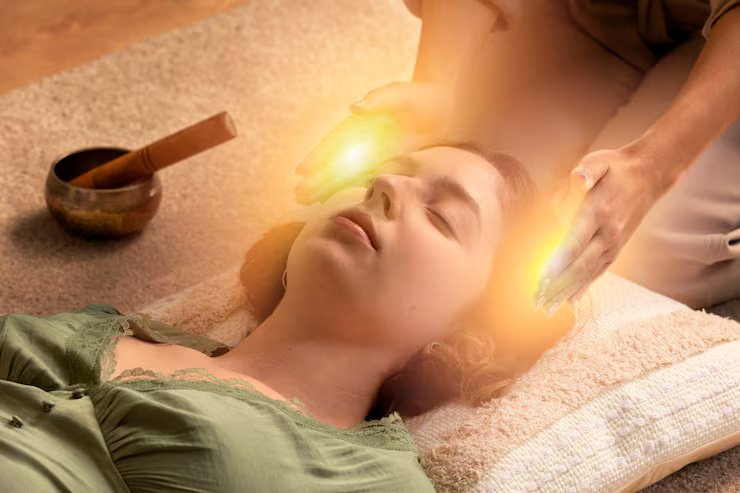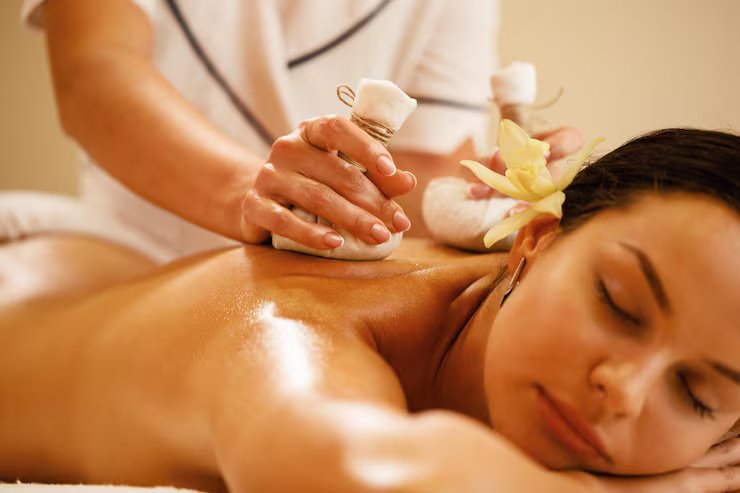Ayurvedic therapy, a cornerstone of traditional Indian medicine, has gained global recognition for its holistic approach to health and wellness. Rooted in centuries-old wisdom, Ayurvedic healing offers personalized treatments using natural healing methods, herbal remedies, and lifestyle guidance.

In this guide, we’ll explore what Ayurvedic therapy is, its benefits, techniques like Panchakarma therapy, how it works, and how to choose the right treatment for your body type.
What Is Ayurvedic Therapy?
Ayurvedic therapy is a form of holistic health practice that combines Ayurveda treatment, Ayurvedic healing, and lifestyle principles to restore balance in the body’s energies—known as doshas (Vata, Pitta, and Kapha). This ancient system originated in India over 5,000 years ago and is recognized by the World Health Organization as a traditional system of medicine.
Treatments include dietary plans, Ayurvedic body massage, detox therapies, herbal supplements, meditation, and yoga.
How Does Ayurvedic Therapy Work?
Ayurvedic therapy is based on the principle of balancing the doshas:
- Vata: governs movement (air & space)
- Pitta: governs metabolism (fire & water)
- Kapha: governs structure and immunity (water & earth)
Every individual has a unique combination of these doshas. Imbalance leads to health issues, and the aim of Ayurvedic treatment is to restore equilibrium through personalized therapies.
Diagnosis Process
An Ayurvedic practitioner performs an in-depth consultation to understand your body constitution (Prakriti), imbalances (Vikriti), diet, lifestyle, emotional health, and medical history.
Techniques like pulse diagnosis, tongue analysis, and observation of physical traits are used. Based on this, a customized plan is created involving dietary changes, yoga, herbal remedies, and detox procedures.
Common Ayurvedic Therapies & Techniques
1. Panchakarma Therapy
Panchakarma is the cornerstone of detoxification therapy in Ayurveda. It is a five-step cleansing and rejuvenation process that removes toxins (ama) from the body.
The Five Panchakarma Procedures:
- Vamana (Therapeutic Vomiting) – Eliminates toxins from the respiratory and digestive system.
- Virechana (Purgation Therapy) – Cleanses liver and gallbladder.
- Basti (Enema Therapy) – Removes accumulated toxins through herbal oils.
- Nasya (Nasal Therapy) – Clears sinuses and balances hormones.
- Raktamokshana (Bloodletting) – Detoxifies blood (rarely used now).
Panchakarma therapy is often combined with a preparatory phase (Purvakarma) involving Ayurvedic massage, steam therapy, and Ayurvedic oils to loosen toxins.
2. Shirodhara Treatment
Shirodhara involves gently pouring warm herbal oil over the forehead in a continuous stream. It calms the nervous system, improves sleep, and balances the mind.
Often used as a therapy for stress, Shirodhara treatment helps reduce anxiety, high blood pressure, and mental fatigue. It’s commonly offered in Ayurvedic spa centers.
3. Abhyanga – Ayurvedic Body Massage
Abhyanga is a full-body massage using warm, medicated oils selected based on your dosha type. The massage enhances circulation, nourishes tissues, and removes impurities.
It’s one of the most sought-after Ayurveda massage therapies.
4. Swedana – Herbal Steam Therapy
Swedana is an Ayurvedic steam treatment that opens up sweat glands to eliminate toxins.
Benefits of Ayurvedic Therapy
1. Stress and Anxiety Relief
One of the most widely recognized benefits of Ayurvedic therapy for stress and anxiety is its calming effect on the nervous system. Treatments like Shirodhara, herbal teas, and meditation reduce cortisol levels and induce mental clarity.
2. Back Pain and Joint Relief
For those seeking the best Ayurvedic therapy for back pain and joint relief, Abhyanga, Basti, and herbal compress therapies help reduce inflammation, lubricate joints, and ease stiffness.
3. Glowing Skin and Hair
Ayurvedic therapy for glowing skin and hair includes internal detoxification and external applications of herbal pastes, oils like Brahmi and Amla, and dietary changes. These restore the body’s internal balance, reflecting on the skin and hair.
4. Weight Management
Through metabolic rebalancing, Ayurvedic therapy for weight loss and metabolism boost offers a sustainable alternative to fad diets. Herbal remedies like Triphala and techniques like Udvartana stimulate digestion and burn fat naturally.
Ayurvedic Therapy vs Regular Massage
| Feature | Ayurvedic Massage | Regular Massage |
|---|---|---|
| Focus | Dosha balance, detox | Muscle relaxation |
| Techniques | Warm herbal oils, marma | Pressure points, strokes |
| Customization | Based on individual dosha | Generic |
| Benefits | Physical, emotional, spiritual | Mostly physical |
| Oils Used | Medicated Ayurvedic oils | Standard massage oils |
Ayurvedic massage goes beyond relaxation—it aims to rejuvenate the entire being by harmonizing bodily energies.
How to Choose the Right Ayurvedic Therapy for Your Body Type
Identifying your dosha type is key:
- Pitta types: Prone to anger, inflammation—benefit from cooling oils, Shirodhara.
- Kapha types: Prone to sluggishness, weight gain—Udvartana and Swedana are ideal.
You can take a dosha quiz online or consult a certified Ayurvedic practitioner to guide your therapy selection. Sites like Ayurveda.com offer useful tools and resources.
Are There Any Side Effects of Ayurvedic Therapy?
- Allergies from improper herbal combinations
- Overuse of strong purgatives or emetics without medical supervision
Ensure that treatments are prescribed based on proper diagnostic evaluation and sourced from authentic Ayurvedic centers.
Holistic Approach to Health: Beyond Just Treatment
Ayurveda emphasizes preventive healthcare. Therapies are complemented with:
- Daily routines (Dinacharya) for healthy habits
- Seasonal routines (Ritucharya) to adapt to weather changes
- Mindful eating based on body type and digestive capacity
- Yoga and meditation for mental and physical balance
Ayurvedic Spa: A Modern Touch to Traditional Healing
Modern-day Ayurvedic spas bring luxurious ambiance to age-old treatments. From stress-relieving Ayurvedic massages to detoxifying Panchakarma sessions, these centers combine comfort with efficacy.
Look for certifications from reputable Ayurvedic institutions like:
- Kerala Ayurveda Academy – www.keralaayurveda.us
- The Ayurvedic Institute – www.ayurveda.com
Conclusion
With a focus on natural healing methods, personalized care, and holistic wellness, Ayurveda continues to transform lives across the globe.



